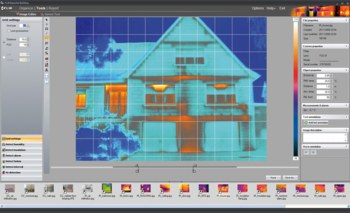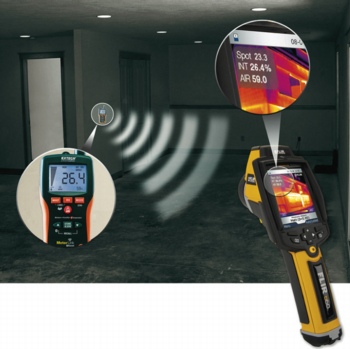The capabilities of thermal imaging

Andy Baker runs though the increasingly cost-effective capabilities of thermal imaging.
In the space of just a few years, there has been a massive escalation in the application scope of thermal imaging in building science. And demand for the technology has grown exponentially with every new application added to the list.
There are many reasons, not least is that the technology is eminently suitable for visualising energy loss and the structural faults that cause it. But a main contributor to its capability has been the parallel development of hardware and application-specific software that has enabled anyone involved in building inspection to do their job more quickly and more efficiently.
The growth in thermal imaging across all industrial sectors has also resulted in the technology being much cheaper. Manufacturing economies of scale mean that an entry-level camera is now under £1000. Whilst this will not buy an infra-red camera that is capable of producing a detailed image for analysis, such a point-and-shoot model will provide a good introduction to this supremely flexible technology.
In line with the price of thermal imaging cameras falling, so too has that of software. Good reporting and analysis software is now available for less than £1000 and adds considerable value to the overall thermal imaging package. Reporting options are now extensive, with packages providing the user with numerous pre-designed report templates.
A report comparing energy costs makes possible the easy calculation of achievable cost savings when structural problems are identified and fixed. Instant reports can now be created in the camera and then downloaded onto a memory stick. The necessary data is then instantly available so that repairs can be scheduled and costs saved.
Application-specific software is considerably enhancing the effectiveness of thermography for set tasks. Indeed the building sector was amongst the first to benefit from the introduction of sector-specific cameras with dedicated application functions.
Cameras have humidity and insulation alarms as well as features such as intelligent image stitching and customised building report templates. These include a humidity inspection report for calculating dew points and an air-tightness report for visualising air infiltration.
Detecting missing insulation and render delamination is now an easy task with thermal imaging. All that is required is a difference of about 10 K between the outside and inside temperature of the building for the user to capture good thermal images that are easy to interpret. A camera with higher resolution and thermal sensitivity can be used with smaller temperature differentials as the image detail will be that much greater as a result.

Identifying areas prone to growth of mould and fungi is also easily achieved with thermal imaging. Often the cause is wet insulation materials due to structural faults or air leakage. Moisture can sometimes be difficult to spot, so the trick is to raise the ambient temperature in the room. Wet material will then become clearly visible as its temperature increases much more slowly than dry material. And the major benefit of infra-red of course is that it can inspect a substantial surface area in a single pass of the camera, whereas other methods only provide a single spot reading.
On the roof, a thermal imaging camera is a real boon. Using the Sun as the heat source makes it easy for the infra-red camera to determine areas of moisture ingress as night falls and the roof cools down. Again, it can see the problem spots because the temperature of the wet insulation reduces at a slower rate, causing a differential that creates a thermal profile.
The integration of the latest data-transfer technology has also extended the capability of thermal imaging. It is now possible, via wireless connection, to transfer data acquired on a meter to a thermal imaging camera. So typically, when the presence of moisture is identified on an infra-red image, an exact reading can be taken by a remote moisture meter. Those readings are then transmitted to the camera and embedded on the image, together with other readings such as relative humidity and ambient temperature.
The wide-ranging ability of today’s thermal imaging camera gives it great cost-saving potential. It is perfectly possible for the same camera to be used to check a roof for water ingress, examine the integrity of building insulation, monitor the efficiency of underground water pipes, inspect bearings on a motor, look for loose terminal connections in a control cabinet or study a dynamic process.
The application potential for infrared is growing daily, and with every new task the camera’s return on the investment is accelerated. However, there is an important caveat. Application training is a vital part of any purchase, particularly in the field of building thermography. The user must understand the physics involved, including factors such as solar reflection and emissivity, in order to interpret findings effectively.
Andy Baker is UK sales manager with Flir Systems.









